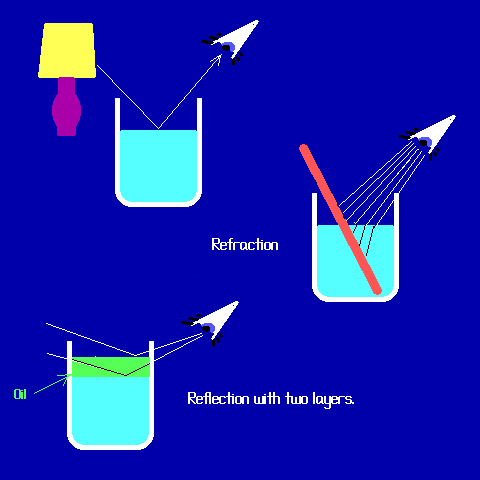Observe reflection and refraction at a boundary layer.


Mirages occur when two air masses of different temperatures are up against each other. The different temperatures will mean the air masses will have different densities (one is heavier per cubic inch than the other.) Light when it passes from a medium with one density to a different density can be refracted (bent) or reflexed (bounced).
While it's difficult to observe reflection or refraction at the boundary layer between densities of air, we can easily see it between air and the heavier medium of water.
STEP 1: Find a clear container like a glass or bottle.
STEP 2: Fill it with tap water to about the 3/4 mark.
STEP 3: Look down at the boundary layer between the water and the air. Notice that some of the light is reflected back so that the surface looks like a mirror. This is especially noticeable if the light source you are using is above the container.
STEP 4: Now hold the container up so that it is above you and the light source. Notice that the boundary layer from below also reflects light.
STEP 5: Take a pencil or straw and put it into the container at an angle. Observe it through the top of the boundary layer. Notice how it appears to be crooked where it passes through the boundary. The pencil isn't bent, but the light rays passing through the boundary layer are bent. Their refraction gives the appearance that the object is bent.
STEP 6: If you have some cooking oil pour it into the top of the container until you have a layer of oil floating on top about a half inch thick. The oil should float on top of the water since it has a lighter density and does not easily mix with water. Pour slowly and try to avoid getting water bubbles in the oil. It may be necessary to gently stir the oil layer until bubbles of water caught in it fall to the bottom of the oil layer.
STEP 7: Notice there are two boundary layers now. One between the air and the oil, the other between the oil and the water. Both will show some reflection and refraction. Reflection at the oil/water boundary will be most noticeable when you look from the side of the container into the oil and down to the boundary with the water.

Copyright Lee Krystek 1996. All Rights Reserved.